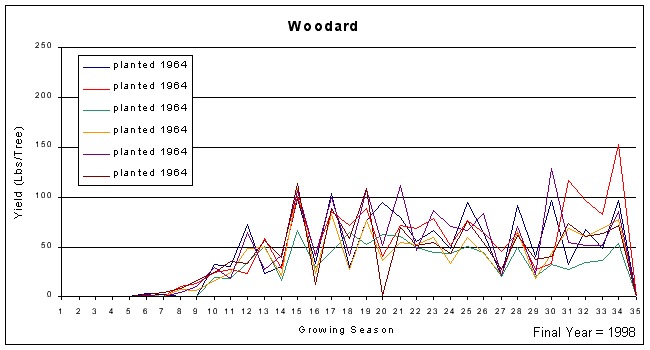Woodard
Average nut quality of test trees.
| # Nuts / lb. | % Kernel | Kernel quality breakdown | Specific gravity | ||
| % Fancy | % Standard | % Amber | |||
| 60 | 55% | 25% | 26% | 4% | .67 |
History
'Woodard' pecan originated in Tift County, Georgia, from a chance seedling located on a farm near Ty Ty. Mr. R.W. Patrick collected samples of the nut, and grafted trees were planted in the cultivar trials of the Experiment Station in 1955. The nut is known locally as 'GCPES Seeling 1' or 'Patrick'. There was already a cultivar known as 'Patrick' so the name was changed to 'Woodard' in honor of O.J. Woodard the late head of the Horticulture Department who propagated and tested it. The original tree was estimated to have been planted around 1900-1910 (Worley and Woodard, 1982). Molecular marker data seems to indicate that 'Woodard' and 'Desirable' are fairly closely related (Conner and Wood, 2001).
Comments
*Note: This is an older cultivar planted in the Old Variety Test at the Tifton Campus. Trees were planted decades ago when care was very different than it is now, and trees received much less care, so production data will reflect this fact. Trees began receiving insecticides in 1962, fungicides in 1970, nitrogen in 1962, and drip irrigation in 1975. The data for this cultivar was collected by several individuals, but the bulk of the data and the comments are from my predecessor Dr. Ray Worley. This information was originally published here: Worley and Mullinix, 1997.
A local nut with extremely thin shell and high percent kernel (55%). It made the top five in average annual yield by the 35th year. It is a consistent yielder of high-quality nuts. Its extremely thin shell may present problems if handled roughly. It would be excellent if marketed to those who shell nuts by hand, since it is so easily cracked. It is susceptible to scab, but routine spray programs easily control the problem. Though also susceptible to powdery mildew, it suffers little damage from the mildew's presence. If it had been marketed early in the 1900's it would have been a very competitive cultivar. Today, however, it can not compete with more modern cultivars and their high kernel quality.
Production record of test trees beginning in year planted
'Woodard' production from the Old Variety Test. Each colored line represents the yearly production in pounds of nuts from an individual tree beginning the year planted.
Alternate Bearing Intensity* = 0.35
*Computed from mature trees using data from years after trees began receiving fertilizer and pesticide sprays.



